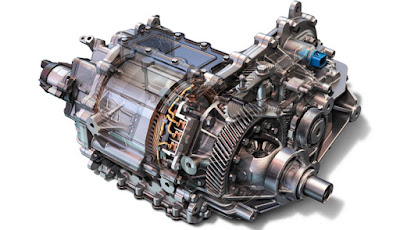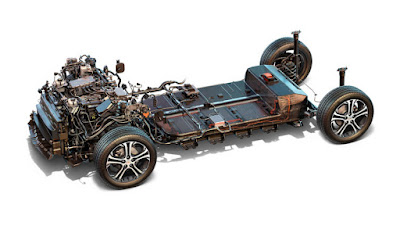Hard on the heels of the reveal of the production Volt EV at CES 2016 in Las Vegas, Chevrolet used the North American International Auto Show in Detroit to release additional details on the battery and drivetrain of the new BEV. Engineers developed the Bolt EV’s propulsion system to offer more than an estimated 200 miles and a sporty driving experience.
The Bolt EV’s drive system uses a single high capacity electric motor to propel the car. The engineering team designed the Bolt EV’s electric motor with an offset gear and shaft configuration tailored to meet efficiency and performance targets—most notably more than an estimated 200 miles of range. The motor is capable of producing up to 266 lb-ft (360 N·m) of torque and 200 hp (150 kW) of motoring power. Combined with a 7.05:1 final drive ratio, it helps propel the Bolt EV from 0-60 mph in less than seven seconds.
Power delivery is controlled by Chevrolet’s first Electronic Precision Shift system. This shift and park-by-wire system sends electronic signals to the Bolt EV’s drive unit to manage precise feel and delivery of power and torque, based on drive mode selection and accelerator inputs. A by-wire shifter requires less packaging space than a traditional mechanical shifter, resulting in more interior space and improved interior layout.Having more than 1.3 billion miles of EV experience from the Chevrolet Volt helped Bolt EV battery engineers and strategic partner LG Electronics to develop an all-new cell and battery pack to offer more than an estimated 200 miles of range. Battery system preliminary specifications include:
Inside the battery pack—which spans the entire floor, from the front foot well to back of the rear seat—is a new cell design and chemistry. The nickel-rich lithium-ion chemistry provides improved thermal operating performance over other chemistries, which requires a smaller active cooling system for more efficient packaging. The chemistry allows the Bolt EV to maintain peak performance in varying climates and driver demands.
The cells are arranged in a “landscape” format and each measures in at only 3.9 ins. (100 mms) high and 13.1 ins. (338 mms) wide providing improved packaging underfloor. The lower profile cell design enabled the vehicle structure team to maximize interior space.
The battery system is mated to a standard equipment 7.2 kW onboard charger for regular overnight charging from a 240-V wall box. A typical commute of 50 miles can be recharged in less than two hours. Bolt EV also features an optional DC Fast Charging system using the industry standard SAE Combo connector. Using DC Fast Charging, the Bolt EV battery can be charged up to 90 miles of range in 30 minutes. Outside temperatures may affect charging times.
Regen System Provides One-Pedal Driving. Regenerative braking has become more than just a tool to boost range, it’s also transformed into a feature that can provide an improved EV driving experience. The Bolt EV features a new regenerative braking system that has the ability to provide one-pedal driving.Through a combination of increased regenerative deceleration and software controls, one pedal driving enables the vehicle to slow down and come to a complete stop without using the brake pedal in certain driving conditions.
When operating the Bolt EV in “Low” mode, or by holding the Regen on Demand paddle located on the back of the steering wheel, the driver can bring the vehicle to a complete stop under most circumstances by simply lifting their foot off the accelerator, although the system does not relieve the need to use the brake pedal altogether.
Operating the Bolt EV in “Drive” mode and not pulling the paddle while decelerating delivers a driving experience where usage of the brake pedal is required to stop.
Overview
Model: | Chevrolet Bolt EV |
Body style / driveline: | front-wheel-drive, five-passenger, five-door all-electric CUV |
Construction: | Steel and Aluminum |
EPA vehicle class: | Small Wagon (EPA does not have a cross-over category) |
Key competitors: | Nissan Leaf, BMW i3, Ford Focus Electric, Kia Soul EV, VW eGolf Mercedes-Benz B-Class Electric |
Manufacturing location: | Orion Township, Mich. |
Battery manufacturing location: | Incheon, South Korea |
Motor and drive unit manufacturing location: | Incheon, South Korea |
Battery System
Type: | rechargeable energy storage system comprising multiple linked modules |
Volume/case: | 285L |
Mass (lb / kg): | 960 lb./435 kg |
Battery chemistry: | lithium-ion |
Thermal system: | liquid active thermal control |
Cells: | 288 |
Electric driving range: | More than 200 miles (GM estimate pending final tests) |
Energy: | 60 kWh |
Warranty: | eight years / 100,000 miles |
Electric Drive
Type: | Single motor and gearset |
Motor: | permanent magnetic drive motor |
Power: | 200 hp/150 kW |
Torque: (lb-ft / Nm): | 266 lb.ft./360 Nm |
Final drive ratio (:1): | 7.05:1 |
Charging Times
120 V: | Available with standard cordset |
240 V: | 50 miles of range in less than 2 hrs. |
SAE Combo DC Fast Charge: | 90 miles in 30 minutes |
Performance
Top speed (mph): | 91 mph / 145 kph * |
0-30 mph: | 2.9s (75% SoC) * |
0-60 mph: | Under 7 seconds |
Chassis/Suspension
Front: | Independent MacPherson strut-type front suspension with side load compensating and finely tuned springs, direct-acting solid stabilizer bar system and ride & handling oriented LCA bushings. |
Rear: | Compound crank (torsion beam) type rear suspension with the closed section V-shaped profile axle; specifically tuned coil springs, performance balanced shock absorber, angled A-bushing supporting understeer tendency on cornering maneuver and kinematically optimized torsion beam providing stable and best ride & handling performance. |
Chassis control: | Four-channel ABS; Traction control system; StabiliTrak; Drag control |
Steering type: | column-mounted electric power steering |
Steering wheel turns, lock-to-lock: | 2.91 revolution * |
Turning radius, curb-to-curb ( ft. / m): | 10.8m * |
Steering ratio: | 16.8 :1 |
Brakes
Type: | power four-wheel disc with ABS; electro-hydraulic; partially regenerative; dynamic rear brake proportioning |
Brake rotor diameter front (mm / in): | 276mm |
Brake rotor diameter rear (mm / in): | 264mm |
Total swept area (cu cm): | Front : 1398.9 Rear : 1131.4 |
Wheels/Tires
Wheel size and type: | 17in x 6.5J offset 44, cast aluminum |
Tires: | Michelin Energy Saver A/S 215/50R17 all-season |
Dimensions
Wheelbase (in / mm): | 102.4 / 2600 |
Overall length (in / mm): | 164.0 / 4166 |
Overall width (in / mm): | 69.5 / 1765(W103) |
Track width front (in / mm): | 1500.92 mm |
Track width rear (in / mm): | 1501.05 mm |
Height (in / mm): | 62.8 / 1594(H100) |
Front overhang (in / mm): | 32.9 / 836 |
Rear overhang (in / mm): | 28.7 / 730 |
Seating capacity (front / rear): | 2 / 3 |
Headroom (in. / mm): | 39.7 / 1009 1st row 37.9 / 962 2nd row |
Shoulder room (in / mm): | 54.6 / 1387 1st row 52.8 / 1340 2nd row |
Hip room (in / mm): | 51.6 / 1310 1st row 50.8 / 290 2nd row |
Legroom (in / mm): | 41.6 / 1056 1st row 36.5 / 927 2nd row |
Cargo volume (cu ft / L): | 16.9 cu-ft / 478 L (V10, Wagon CVI – Max behind rear seat) |
Passenger volume (cu ft / L): | PV1 52.2 cu-ft / 1478 L 1st row PV2 42.2 cu-ft / 1195 L 2nd row |
Capacities
Curb weight (lb / kg); | 3580 lb / 1625kg based on target (w/o 2passengers) |
Heating cooling (qt / L): | Heating loop 1.8L |
Battery pack cooling (qt / L): | 6.9L (RESS cooling loop total coolant volume) |
Power electronics cooling (qt / L): | 3.9L (PE & DU cooling loop total coolant volume) |
Drive unit fluid (qt / L): | 2.9L |






